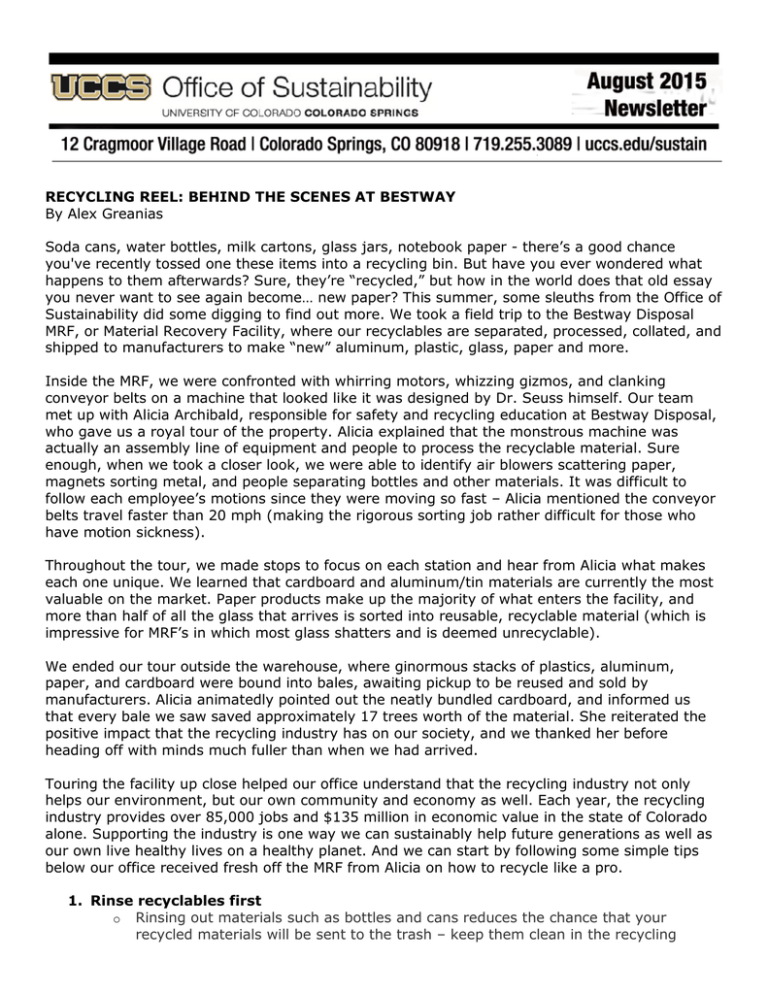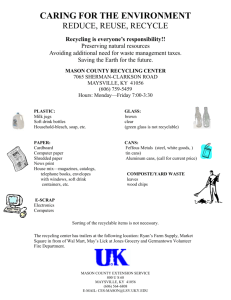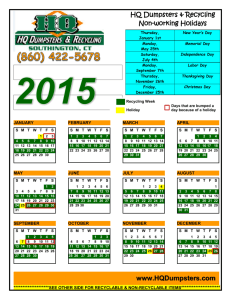By Alex Greanias RECYCLING REEL: BEHIND THE SCENES AT BESTWAY
advertisement

RECYCLING REEL: BEHIND THE SCENES AT BESTWAY By Alex Greanias Soda cans, water bottles, milk cartons, glass jars, notebook paper - there’s a good chance you've recently tossed one these items into a recycling bin. But have you ever wondered what happens to them afterwards? Sure, they’re “recycled,” but how in the world does that old essay you never want to see again become… new paper? This summer, some sleuths from the Office of Sustainability did some digging to find out more. We took a field trip to the Bestway Disposal MRF, or Material Recovery Facility, where our recyclables are separated, processed, collated, and shipped to manufacturers to make “new” aluminum, plastic, glass, paper and more. Inside the MRF, we were confronted with whirring motors, whizzing gizmos, and clanking conveyor belts on a machine that looked like it was designed by Dr. Seuss himself. Our team met up with Alicia Archibald, responsible for safety and recycling education at Bestway Disposal, who gave us a royal tour of the property. Alicia explained that the monstrous machine was actually an assembly line of equipment and people to process the recyclable material. Sure enough, when we took a closer look, we were able to identify air blowers scattering paper, magnets sorting metal, and people separating bottles and other materials. It was difficult to follow each employee’s motions since they were moving so fast – Alicia mentioned the conveyor belts travel faster than 20 mph (making the rigorous sorting job rather difficult for those who have motion sickness). Throughout the tour, we made stops to focus on each station and hear from Alicia what makes each one unique. We learned that cardboard and aluminum/tin materials are currently the most valuable on the market. Paper products make up the majority of what enters the facility, and more than half of all the glass that arrives is sorted into reusable, recyclable material (which is impressive for MRF’s in which most glass shatters and is deemed unrecyclable). We ended our tour outside the warehouse, where ginormous stacks of plastics, aluminum, paper, and cardboard were bound into bales, awaiting pickup to be reused and sold by manufacturers. Alicia animatedly pointed out the neatly bundled cardboard, and informed us that every bale we saw saved approximately 17 trees worth of the material. She reiterated the positive impact that the recycling industry has on our society, and we thanked her before heading off with minds much fuller than when we had arrived. Touring the facility up close helped our office understand that the recycling industry not only helps our environment, but our own community and economy as well. Each year, the recycling industry provides over 85,000 jobs and $135 million in economic value in the state of Colorado alone. Supporting the industry is one way we can sustainably help future generations as well as our own live healthy lives on a healthy planet. And we can start by following some simple tips below our office received fresh off the MRF from Alicia on how to recycle like a pro. 1. Rinse recyclables first o Rinsing out materials such as bottles and cans reduces the chance that your recycled materials will be sent to the trash – keep them clean in the recycling stream! 2. Separate non-recyclable lids o Many recyclable cups and containers often have a plastic, non-recyclable cap or lid. Check for a recycling symbol on lids before tossing them in the recycling bin. 3. Keep items in their original form o Crushing items such as soda cans and milk cartons often make it difficult for MRF sorters to recognize them. You don’t have to do anything special – just toss them in as is. It’s that easy! To find out more about the Bestway MRF, or schedule a tour to go visit the facility in person, feel free to visit http://bestwaydisposal.com/recycling/mrf-facility/ for additional information. Thanks for tuning in to our recycling reel, and happy recycling, sustainable scholars!









